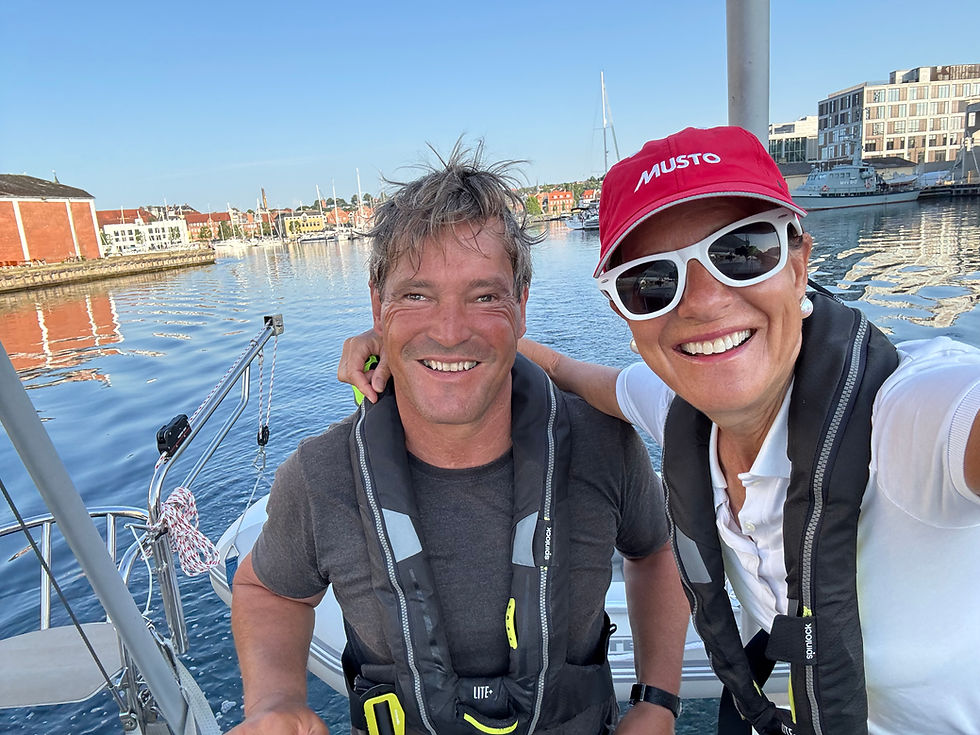Borkum-Hafen
- Beth Solomon

- Jul 14, 2024
- 4 min read

Having survived “Gale Day” in Terschelling quite enjoyably after discovering the Dutch practice of “niksen,” or doing nothing, we were ready for an early launch eastward. The sail from Terschelling to Borkum would entail 80 miles, or 14 hours, we estimated.

The first leg of the journey was westward, to avoid the North Sea square miles of shallows that were notorious for shipwrecks — and local pirates — for centuries. We motored against the wind, and after about two hours, set sail headed to our first stop in Germany, a few islands away. With 18-20 knot winds, we unfurled our genoa and quickly started making speed, six knots and change. On Star Mist, due to its mere 11 meters (35 feet) of length, we rarely reach a speed of seven knots, and estimate our average speed for passage planning at five knots per hour. So six to 6.5 knots made us happy. Because of the angle of the wind and swell, we didn’t raise the mainsail lest we would have to be constantly on alert for accidental jibes. The ride was smooth if a little rolly. That’s normal with a tailwind and four-foot swell.

We stared in awe as squall after squall marched alongside Star Mist, with nary a raindrop sprinkling us. As we (gently) jibed to a more southerly route for our final stretch to Borkum, we hoisted the mainsail with two reefs (smaller sail area, less power) and were thrilled to catch the breezes, but not the downpours, of the angry squalls. Then, our luck ran out. All of a sudden, a 30-knot blast of wind slammed into our sails from behind. As Star Mist heeled sharply, the gusts were so powerful that our autopilot let go, sending us into a freaky spin. The boom whipped around like a baseball bat. Our genoa flapped and slapped the rigging in a frenzy. The force of the gusts was so strong that furling the genoa took both of us using all our strength, like we were pulling a cow out of the sea. At the same time, Gero released the boom so the wind couldn’t pin our mast toward the sea. “OK babe, start the engine, and I’ll bring down the mainsail.” As I revved up the Volvo, we curved into the wind. Gero cleated himself to the safety lines running down the center of Star Mist, harnessed the sails, and we started into the shallow waters near Borkum.

After 13 hours of sailing, we were spent — ready to tie up for the night. The voice answering the phone line at Port Henry Marina was welcoming but uncertain. The entrance, she had said the day before, was dredged out last week. “We think you can enter with your 1.9 meter draft, but better to wait until two hours after low tide, which is at 6:30 pm,” she specified in clear German. When we called again an hour before making landfall, the voice at Port Henry informed us of a sailboat waiting to enter. We could see “Quo Vadis” on our navigation system, floating near the entrance to the marina for at least an hour already. Hmmm. As we entered the marina, we could see the “waiting” Dutch sailboat tied to a wooden post. Waving their arms, the sailors on Quo Vadis shouted at us. “Go back! Go back! We’re stuck!! The water is too shallow!!” But it was too late, we were already in the entry channel, and our depth meter said 0.0 meters!! Would we also get stuck in the mud??

Gero spun Star Mist like a top. “Are you OK?” I shouted to the couple. “We're OK! We’re waiting for the tide to come in!!” We pointed to the commercial ship marina further east and hoped the incoming tide would save the day. By the time we puttered into the cavernous industrial marina, boats were packed together like sardines, tied to one another against the forboding walls of the rough-looking port. “We’ve never done this before!” I called to a young, blond Dutchman waiting on his sailboat as we approached to parallel park next to his. Even at the slowest speeds, these boats weigh so much that a hand caught in between two vessels will be crushed like a cracker.

Max (who we would get to know much better in the coming days) called back, “Don’t panic, I’ve got you.“ Gero inched toward Zeevonk, Max’s 37-footer. “Bow thrust, neutral…” he called out calmly. “Reverse a little. Reverse.” I threw our heavy spring line with all my might at Max, who grabbed it and quickly tied us to Zeevonk. We exhaled. It turned out, Max and Mette Schoon had tried to tow stranded Quo Vadis — first with Zeevonk, and then with the engine-equipped dinghy they towed behind them. It couldn’t be done because of the shallows and the razor thinness of the channels. “This is the worst marina I’ve ever seen,” said Morris, now unstuck, sipping a Warsteiner. He and his lovely co-captain Heleen van Tholen spoke the truth.

But now, all still floating and tied in, we could break out beverages, lean back on our platform of sailboats, and relax, tied together to a powerboat and another sloop buffering us from the towering marina wall. Secure in the platform at 9:00 pm, we collapsed into a deep sleep in the late North Sea dusk... #sailing #siriusyachts




Comments